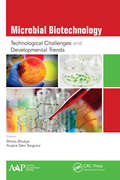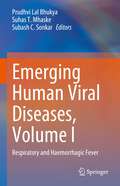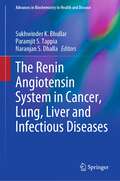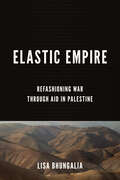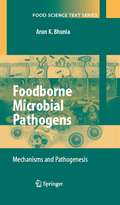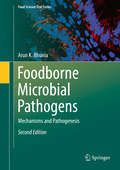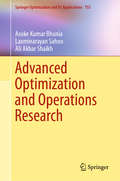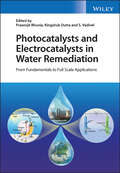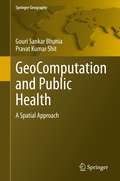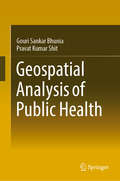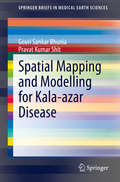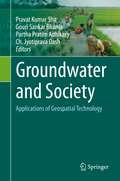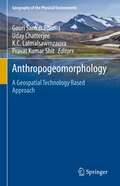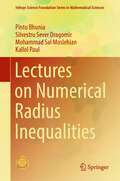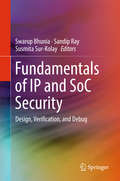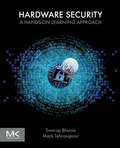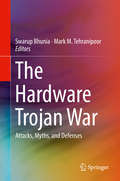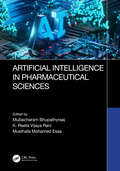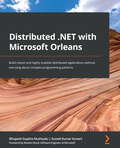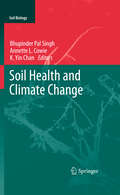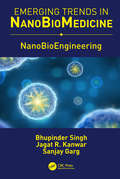- Table View
- List View
Microbial Biotechnology: Technological Challenges and Developmental Trends
by Bhima Bhukya Anjana Devi TanguturThe new volume takes an interdisciplinary look at current technical challenges and recent developmental trends in microbial biotechnology. It covers an avalanche of new information available through research by focusing on a broad spectrum of issues on different microorganisms and their recent applications and implications in agriculture, soil science and forestry, industry, and public health and medicine. Microbes present in our immediate environment have a direct or indirect influence leading to either a harmful or beneficial effect. Microbial Biotechnology: Technological Challenges and Developmental Trends is divided into four major sections that focus on Part I: Antimicrobial Agents: Role and Applications in Medicine and Health Care Part II: Role of Microorganisms in Agriculture and Plant Biotechnology Part III: Microbial Enzymes and Their Potential Industrial Applications Part IV: Microorganisms in Environment: Role and Industrial Applications Topic include organic chemistry, biomass conversion, optimal production processes for different microbes, screening methods, and application of omics approaches such as (meta) genomics, proteomics, and metabolomics, or other biotechnology tools, to provide a deeper understanding of the microbial-based new and emerging products, trends, processes, and technologies. The chapters present unbiased original research results on microbes by incorporating case studies wherever appropriate. Providing research findings applicable to the development of new methodologies, applications, and technologies, the book will be a valuable resource for people working in various fields of microbiology.
Emerging Human Viral Diseases, Volume I: Respiratory and Haemorrhagic Fever
by Prudhvi Lal Bhukya Suhas T. Mhaske Subash C. SonkarThe first volume of the book-Emerging Human Viral diseases presents pathogenesis, diagnostics, and therapeutic strategies against viral respiratory and hemorrhagic fever diseases. The initial chapter discusses the underlying factors contributing to the emergence of these viral diseases. The subsequent chapters introduce structure, composition, and organization of viral genomes, and provide insight into function of important viral proteins. It also discusses the host factors that influence the outcome of viral infection and host immune response to the infections caused by these viruses. The book also discusses clinical manifestation and strategies for the prevention of virus diseases and highlights the recent technical advances in the diagnosis of virus diseases, prevention, and control strategies for viral infections. This timely book offers valuable resource for the scientists working in the field of emerging viral infections and those involved in preventing, controlling, and managing viral diseases.
The Renin Angiotensin System in Cancer, Lung, Liver and Infectious Diseases (Advances in Biochemistry in Health and Disease #25)
by Sukhwinder K. Bhullar Paramjit S. Tappia Naranjan S. DhallaThis book of the series on “Advances in Biochemistry in Health and Disease” includes state-of-the-art information on the status of renin-angiotensin system (RAS) in the form of 24 chapters. This book has been organized into three sections: (i) General Implications of RAS in human health and Infectious Diseases, (ii) Lung, Liver and Kidney Diseases, and (iii) Development of Cancer. Each chapter has discussed comprehensive knowledge regarding the molecular and cellular aspects of the role of RAS in the pathophysiology and pharmacotherapy of different disease processes. Biochemical mechanisms associated with angiotensin II type 1 and type II receptors, and angiotensin (1-7) MAS receptors for the occurrence of both harmful and beneficial effects of prolonged activation of RAS in different diseases have been outlined. It is noteworthy to point out that different chapter in this book were prepared by recognized global expertise in the area of inflammation, oxidative stress and signal transduction pathways to highlight the role of RAS in different diseases. It is our sincere hope that this book will be of great interest to both biomedical investigators and health professionals as well as graduate students and postdoctoral fellows all over the world.
Elastic Empire: Refashioning War through Aid in Palestine (Stanford Studies in Middle Eastern and Islamic Societies and Cultures)
by Lisa BhungaliaThe United States integrated counterterrorism mandates into its aid flows in the West Bank and Gaza Strip during the early years of the global war on terror. Some two decades later, this securitized model of aid has become normalized across donor intervention in Palestine. Elastic Empire traces how foreign aid, on which much of the Palestinian population is dependent, has multiplied the sites and means through which Palestinian life is regulated, surveilled, and policed—this book tells the story of how aid has also become war. Drawing on extensive research conducted in Palestine, Elastic Empire offers a novel accounting of the US security state. The US war chronicled here is not one of tanks, grenades, and guns, but a quieter one waged through the interlacing of aid and law. It emerges in the infrastructures of daily life—in a greenhouse and library, in the collection of personal information and mapping of land plots, in the halls of municipal councils and in local elections—and indelibly transfigures lives. Situated in a landscape where the lines between humanitarianism and the global war on terror are increasingly blurred, Elastic Empire reveals the shape-shifting nature of contemporary imperial formations, their realignments and reformulations, their haunted sites, and their obscured but intimate forms.
Elastic Empire: Refashioning War through Aid in Palestine (Stanford Studies in Middle Eastern and Islamic Societies and Cultures)
by Lisa BhungaliaThe United States integrated counterterrorism mandates into its aid flows in the West Bank and Gaza Strip during the early years of the global war on terror. Some two decades later, this securitized model of aid has become normalized across donor intervention in Palestine. Elastic Empire traces how foreign aid, on which much of the Palestinian population is dependent, has multiplied the sites and means through which Palestinian life is regulated, surveilled, and policed—this book tells the story of how aid has also become war. Drawing on extensive research conducted in Palestine, Elastic Empire offers a novel accounting of the US security state. The US war chronicled here is not one of tanks, grenades, and guns, but a quieter one waged through the interlacing of aid and law. It emerges in the infrastructures of daily life—in a greenhouse and library, in the collection of personal information and mapping of land plots, in the halls of municipal councils and in local elections—and indelibly transfigures lives. Situated in a landscape where the lines between humanitarianism and the global war on terror are increasingly blurred, Elastic Empire reveals the shape-shifting nature of contemporary imperial formations, their realignments and reformulations, their haunted sites, and their obscured but intimate forms.
Foodborne Microbial Pathogens: Mechanisms and Pathogenesis (Food Science Text Series)
by Arun BhuniaAt last, here is a graduate-level textbook that focuses on the very latest information on the molecular and cellular mechanism of several major foodborne bacterial pathogens. For the first time in the field, this book makes the link between foodborne illness and immunology. It also covers virulence genes and their regulation in the host or the food environment, pathogenicity testing models, clinical symptoms and prevention and control strategies. Unlike other textbooks this one also covers the host/parasite interaction to a level where readers have a real appreciation of the disease mechanism. It is imperative that we acquire a better understanding of foodborne pathogens. And this is what this brilliant and timely contribution to the subject offers.
Foodborne Microbial Pathogens: Mechanisms and Pathogenesis (Food Science Text Series)
by Arun K. BhuniaThis book primarily covers the general description of foodborne pathogens and their mechanisms of pathogenesis, control and prevention, and detection strategies, with easy-to-comprehend illustrations. The book is an essential resource for food microbiology graduate or undergraduate students, microbiology professionals, and academicians involved in food microbiology, food safety, and food defense-related research or teaching. This new edition covers the significant progress that has been made since 2008 in understanding the pathogenic mechanism of some common foodborne pathogens, and the host-pathogen interaction. Foodborne and food-associated zoonotic pathogens, responsible for high rates of mortality and morbidity, are discussed in detail. Chapters on foodborne viruses, parasites, molds and mycotoxins, and fish and shellfish are expanded. Additionally, chapters on opportunistic and emerging foodborne pathogens including Nipah virus, Ebola virus, Aeromonas hydrophila, Brucella abortus, Clostridium difficile, Cronobacter sakazakii, and Plesiomonas shigelloides have been added. The second edition contains more line drawings, color photographs, and hand-drawn illustrations.
Advanced Optimization and Operations Research (Springer Optimization and Its Applications #153)
by Asoke Kumar Bhunia Laxminarayan Sahoo Ali Akbar ShaikhThis textbook provides students with fundamentals and advanced concepts in optimization and operations research. It gives an overview of the historical perspective of operations research and explains its principal characteristics, tools, and applications. The wide range of topics covered includes convex and concave functions, simplex methods, post optimality analysis of linear programming problems, constrained and unconstrained optimization, game theory, queueing theory, and related topics. The text also elaborates on project management, including the importance of critical path analysis, PERT and CPM techniques. This textbook is ideal for any discipline with one or more courses in optimization and operations research; it may also provide a solid reference for researchers and practitioners in operations research.
Photocatalysts and Electrocatalysts in Water Remediation: From Fundamentals to Full Scale Applications
by Dr Prasenjit Bhunia Dr Kingshuk Dutta Dr S. VadivelPhotocatalysts and Electrocatalysts in Water Remediation Comprehensive resource describing the fundamentals, synthesis, and commercial applications of photocatalysts and electrocatalysts in water decontamination Photocatalysts and Electrocatalysts in Water Remediation introduces the fundamentals of both photo- and electro-catalysts and highlights the potentials of photo- and electro-catalysis towards water decontamination, covering strategies to improve photo- and electro-catalytic efficacies, functions of photo- and electro-catalysts and involved chemical reactions, and challenges and recent developments in the field, with additional discussion of both lab-scale and commercial-scale materials and processes. As a forward-thinking resource, the text also discusses the scope of further research on photo-, electro- and electrophoto-catalysts. Edited by three highly qualified professionals, with significant experience in the field, the text is further enriched with critically analyzed and expertly opined contributions from several well-known researchers around the world. In Photocatalysts and Electrocatalysts in Water Remediation, readers can expect to find information on: Fundamentals and functional mechanisms of photocatalysis in water treatment, and different synthetic routes and band gap engineering of photocatalysts Photocatalytic decontamination of organic pollutants from water and photocatalytic removal of heavy metal ions from water Smart photocatalysts in water remediation Fundamentals and functional mechanisms of electrocatalysis in water treatment Electrocatalytic degradation of organic pollutants and removal of heavy metal ions from water Different synthetic routes of electrocatalysts and fabrication of electrodes and combined electro-photocatalytic techniques in water remediation Photocatalysts and Electrocatalysts in Water Remediation serves as one of the most comprehensive and authoritative resources that has ever been published in this field and is a thoroughly complete source of information on the subject for researchers across a myriad of disciplines along with water industry professionals.
GeoComputation and Public Health: A Spatial Approach (Springer Geography)
by Gouri Sankar Bhunia Pravat Kumar ShitGeoComputation and Public Health is fundamentally a multi-disciplinary book, which presents an overview and case studies to exemplify numerous methods and solicitations in addressing vectors borne diseases (e.g, Visceral leishmaniasis, Malaria, Filaria). This book includes a practical coverage of the use of spatial analysis techniques in vector-borne disease using open source software solutions. Environmental factors (relief characters, climatology, ecology, vegetation, water bodies etc.) and socio-economic issues (housing type & pattern, education level, economic status, income level, domestics’ animals, census data, etc) are investigated at micro -level and large scale in addressing the various vector-borne disease. This book will also generate a framework for interdisciplinary discussion, latest innovations, and discoveries on public health. The first section of the book highlights the basic and principal aspects of advanced computational practices. Other sections of the book contain geo-simulation, agent-based modeling, spatio-temporal analysis, geospatial data mining, various geocomputational applications, accuracy and uncertainty of geospatial models, applications in environmental, ecological, and biological modeling and analysis in public health research. This book will be useful to the postgraduate students of geography, remote sensing, ecology, environmental sciences and research scholars, along with health professionals looking to solve grand challenges and management on public health.
Geospatial Analysis of Public Health (Global Perspectives on Health Geography)
by Gouri Sankar Bhunia Pravat Kumar ShitThis book is specifically designed to serve the community of postgraduates and researchers in the fields of epidemiology, health GIS, medical geography, and health management. It starts with the basic concepts and role of remote sensing, GIS in Kala-azar diseases. The book gives an exhaustive coverage of Satellite data, GPS, GIS, spatial and attribute data modeling, and geospatial analysis of Kala-azar diseases. It also presents the modern trends of remote sensing and GIS in health risk assessment with an illustrated discussion on its numerous applications.
Spatial Mapping and Modelling for Kala-azar Disease (SpringerBriefs in Medical Earth Sciences)
by Gouri Sankar Bhunia Pravat Kumar ShitThis book addresses the current challenges in controlling Kala-azar disease (Visceral leishmaniasis) in India and other VL-endemic areas, and aims to develop and apply a geo-environmental risk model based on primary and secondary data with the aid of remote sensing and GIS technologies to assess and mitigate Kala-azar transmission. Through case studies carried out in India, the book provides insight into the relationship between geo-environmental variables and encroachments of Kala-azar, and identifies potential pathways for VL introduction to develop mitigation strategies using GIS and remote sensing technologies. The book critically assesses existing VL mitigation measures that do not adequately account for geo-environmental conditions, and analyzes the environmental factors that aid Kala-azar transmission using remote sensing, spatial statistics and data mining techniques. The book will be of interest to epidemiologists, researchers and practitioners using geospatial data practices to study disease transmission and associated monitoring technologies.
Groundwater and Society: Applications of Geospatial Technology
by Gouri Sankar Bhunia Pravat Kumar Shit Partha Pratim Adhikary Ch. Jyotiprava DashThis volume advances the scientific understanding, development, and application of geospatial technologies related to groundwater resource management, mapping, monitoring, and modelling using up-to-date remote sensing and GIS techniques. The book further provides a critical analysis of the debates and discourses surrounding groundwater resources and society, illustrates the relationship between groundwater resources and precision agriculture for societal development, and describes novel, region-specific management strategies and techniques for sustainability with case studies. The book is organized into three parts: (I) Groundwater resources and societal development; (II) Groundwater availability, quality and pollution; and (III) Sustainable groundwater resources management. Each section begins with a short introduction that includes an overview of the papers in that section. Individual chapters focus on the core themes of research and knowledge along with some topics that have received lesser attention. The book will be of interest to water resource planners and decision-makers, academic researchers, policy makers, NGOs, and academic researchers and students in Geography, Geophysics, Hydrology, Remote Sensing & GIS, Agriculture, Soil Science, and Agronomy.
Anthropogeomorphology: A Geospatial Technology Based Approach (Geography of the Physical Environment)
by Gouri Sankar Bhunia Pravat Kumar Shit Uday Chatterjee K. C. LalmalsawmzauvaThis book explores state-of-art techniques based on open-source software and statistical programming and modelling in modern geospatial applications, specifically focusing on recent trends in data mining techniques and robust modelling in Geomorphological, Hydrological, Bio-physical and Social activities. The book is organized into physical, mountainous, coastal, riverine, forest, urban and biological activities, with each chapter providing a review of the current knowledge in the focus area, and evaluating where future efforts should be directed. The text compiles a collection of recent developments and rigorous applications of Geospatial computational intelligence (e.g., artificial neural network, spatial interpolation, physical and environmental modelling and machine learning algorithms etc) in geomorphic processes from a team of expert contributors. The authors address the wide range of challenges and uncertainties in the study of earth system dynamics due to climate change, and complex anthropogenic interferences where spatial modelling may be applied in the risk assessment of vulnerable geomorphological landscapes. The book will act as a guide to find recent advancements in geospatial artificial intelligence techniques and its application to natural and social hazards. This information will be helpful for students, researchers, policy makers, environmentalists, planners involved in natural hazard and disaster management, NGOs, and government organizations.
Lectures on Numerical Radius Inequalities (Infosys Science Foundation Series)
by Pintu Bhunia Silvestru Sever Dragomir Mohammad Sal Moslehian Kallol PaulThis book is a self-contained advanced monograph on inequalities involving the numerical radius of bounded linear operators acting on complex Hilbert spaces. The study of numerical range and numerical radius has a long and distinguished history starting from the Rayleigh quotients used in the 19th century to nowadays applications in quantum information theory and quantum computing.This monograph is intended for use by both researchers and graduate students of mathematics, physics, and engineering who have a basic background in functional analysis and operator theory. The book provides several challenging problems and detailed arguments for the majority of the results. Each chapter ends with some notes about historical views or further extensions of the topics. It contains a bibliography of about 180 items, so it can be used as a reference book including many classical and modern numerical radius inequalities.
Photocatalysts and Electrocatalysts in Water Remediation: From Fundamentals to Full Scale Applications
by Prasenjit Bhunia Kingshuk Dutta S. VadivelPhotocatalysts and Electrocatalysts in Water Remediation Comprehensive resource describing the fundamentals, synthesis, and commercial applications of photocatalysts and electrocatalysts in water decontamination Photocatalysts and Electrocatalysts in Water Remediation introduces the fundamentals of both photo- and electro-catalysts and highlights the potentials of photo- and electro-catalysis towards water decontamination, covering strategies to improve photo- and electro-catalytic efficacies, functions of photo- and electro-catalysts and involved chemical reactions, and challenges and recent developments in the field, with additional discussion of both lab-scale and commercial-scale materials and processes. As a forward-thinking resource, the text also discusses the scope of further research on photo-, electro- and electrophoto-catalysts. Edited by three highly qualified professionals, with significant experience in the field, the text is further enriched with critically analyzed and expertly opined contributions from several well-known researchers around the world. In Photocatalysts and Electrocatalysts in Water Remediation, readers can expect to find information on: Fundamentals and functional mechanisms of photocatalysis in water treatment, and different synthetic routes and band gap engineering of photocatalysts Photocatalytic decontamination of organic pollutants from water and photocatalytic removal of heavy metal ions from water Smart photocatalysts in water remediation Fundamentals and functional mechanisms of electrocatalysis in water treatment Electrocatalytic degradation of organic pollutants and removal of heavy metal ions from water Different synthetic routes of electrocatalysts and fabrication of electrodes and combined electro-photocatalytic techniques in water remediation Photocatalysts and Electrocatalysts in Water Remediation serves as one of the most comprehensive and authoritative resources that has ever been published in this field and is a thoroughly complete source of information on the subject for researchers across a myriad of disciplines along with water industry professionals.
Fundamentals of IP and SoC Security: Design, Verification, and Debug
by Swarup Bhunia Sandip Ray Susmita Sur-KolayThis book is about security in embedded systems and it provides an authoritative reference to all aspects of security in system-on-chip (SoC) designs. The authors discuss issues ranging from security requirements in SoC designs, definition of architectures and design choices to enforce and validate security policies, and trade-offs and conflicts involving security, functionality, and debug requirements. Coverage also includes case studies from the “trenches” of current industrial practice in design, implementation, and validation of security-critical embedded systems. Provides an authoritative reference and summary of the current state-of-the-art in security for embedded systems, hardware IPs and SoC designs; Takes a "cross-cutting" view of security that interacts with different design and validation components such as architecture, implementation, verification, and debug, each enforcing unique trade-offs; Includes high-level overview, detailed analysis on implementation, and relevant case studies on design/verification/debug issues related to IP/SoC security.
Hardware Security: A Hands-on Learning Approach
by Swarup Bhunia Mark TehranipoorHardware Security: A Hands-On Learning Approach provides a broad, comprehensive and practical overview of hardware security that encompasses all levels of the electronic hardware infrastructure. It covers basic concepts like advanced attack techniques and countermeasures that are illustrated through theory, case studies and well-designed, hands-on laboratory exercises for each key concept. The book is ideal as a textbook for upper-level undergraduate students studying computer engineering, computer science, electrical engineering, and biomedical engineering, but is also a handy reference for graduate students, researchers and industry professionals. For academic courses, the book contains a robust suite of teaching ancillaries. Users will be able to access schematic, layout and design files for a printed circuit board for hardware hacking (i.e. the HaHa board) that can be used by instructors to fabricate boards, a suite of videos that demonstrate different hardware vulnerabilities, hardware attacks and countermeasures, and a detailed description and user manual for companion materials.Provides a thorough overview of computer hardware, including the fundamentals of computer systems and the implications of security risks Includes discussion of the liability, safety and privacy implications of hardware and software security and interaction Gives insights on a wide range of security, trust issues and emerging attacks and protection mechanisms in the electronic hardware lifecycle, from design, fabrication, test, and distribution, straight through to supply chain and deployment in the fieldA full range of instructor and student support materials can be found on the authors' own website for the book: http://hwsecuritybook.org
The Hardware Trojan War: Attacks, Myths, and Defenses
by Swarup Bhunia Mark M. TehranipoorThis book, for the first time, provides comprehensive coverage on malicious modification of electronic hardware, also known as, hardware Trojan attacks, highlighting the evolution of the threat, different attack modalities, the challenges, and diverse array of defense approaches. It debunks the myths associated with hardware Trojan attacks and presents practical attack space in the scope of current business models and practices. It covers the threat of hardware Trojan attacks for all attack surfaces; presents attack models, types and scenarios; discusses trust metrics; presents different forms of protection approaches – both proactive and reactive; provides insight on current industrial practices; and finally, describes emerging attack modes, defenses and future research pathways.
Artificial intelligence in Pharmaceutical Sciences
by Mullaicharam Bhupathyraaj K. Reeta Vijaya Rani Musthafa Mohamed EssaThis cutting-edge reference book discusses the intervention of artificial intelligence in the fields of drug development, modified drug delivery systems, pharmaceutical technology, and medical devices development. This comprehensive book includes an overview of artificial intelligence in pharmaceutical sciences and applications in the drug discovery and development process. It discusses the role of machine learning in the automated detection and sorting of pharmaceutical formulations. It covers nanosafety and the role of artificial intelligence in predicting potential adverse biological effects. FEATURES Includes lucid, step-by-step instructions to apply artificial intelligence and machine learning in pharmaceutical sciences Explores the application of artificial intelligence in nanosafety and prediction of potential hazards Covers application of artificial intelligence in drug discovery and drug development Reviews the role of artificial intelligence in assessment of pharmaceutical formulations Provides artificial intelligence solutions for experts in the pharmaceutical and medical devices industries This book is meant for academicians, students, and industry experts in pharmaceutical sciences, medicine, and pharmacology.
Artificial intelligence in Pharmaceutical Sciences
by Mullaicharam Bhupathyraaj Reeta Vijaya Rani, K. Musthafa Mohamed EssaThis cutting-edge reference book discusses the intervention of artificial intelligence in the fields of drug development, modified drug delivery systems, pharmaceutical technology, and medical devices development. This comprehensive book includes an overview of artificial intelligence in pharmaceutical sciences and applications in the drug discovery and development process. It discusses the role of machine learning in the automated detection and sorting of pharmaceutical formulations. It covers nanosafety and the role of artificial intelligence in predicting potential adverse biological effects. FEATURES Includes lucid, step-by-step instructions to apply artificial intelligence and machine learning in pharmaceutical sciences Explores the application of artificial intelligence in nanosafety and prediction of potential hazards Covers application of artificial intelligence in drug discovery and drug development Reviews the role of artificial intelligence in assessment of pharmaceutical formulations Provides artificial intelligence solutions for experts in the pharmaceutical and medical devices industries This book is meant for academicians, students, and industry experts in pharmaceutical sciences, medicine, and pharmacology.
Distributed .NET with Microsoft Orleans: Build Robust And Highly Scalable Distributed Applications Without Worrying About Complex Programming Patterns
by Bhupesh Guptha Muthiyalu, Suneel Kumar KunaniBuild robust and highly scalable distributed applications without worrying about complex programming patterns
Soil Health and Climate Change (Soil Biology #29)
by Bhupinder Pal Singh, Annette L. Cowie and K. Yin Chan“Soil Health and Climate Change” presents a comprehensive overview of the concept of soil health, including the significance of key soil attributes and management of soil health in conventional and emerging land use systems in the context of climate change.Starting with a review of the physical, chemical and biological indicators of soil health and their significance for monitoring the impacts of climate change, this book then focuses on describing the role of soil structure, pH, organic matter, nitrogen, respiration and biota in sustaining the basic functions of soil ecosystems, and their anticipated responses to climate change. Further topics include the management of cropping, pastoral, and forestry systems, and rehabilitated mine sites, with a focus on mitigation of and adaptation to climate change impacts. Finally, the opportunities and potential risks of organic farming, biochar and bioenergy systems, and their ability to sustain and even enhance soil health, are discussed.
NanoBioEngineering
by Bhupinder Singh, Jagat R. Kanwar and Sanjay GargThe objective of this book is to provide the fundamental comprehension of a broad range of topics in an integrated volume such that readership hailing from diverse disciplines can rapidly acquire the necessary background for applying it in pertinent research and development field.
The Wily Agent and The Zero Cost Mission
by Amar BhushanThis book consists of two stories — ‘Zero Cost Mission’, which unravels the covert operation against Jamaat, and ‘Wily Agent’, which digs up a spectacular operation launched by R&AW in the 1990s to recruit a top asset in Bangladeshi establishment while providing us a peep inside the inner working of the spy agency, the perils of running agents beyond the border and sibling rivalry within the system.
